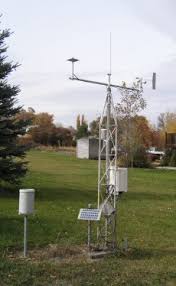Instrument Support Level 3
Campbell Scientific
Not Applicable
Calendar

Campbell Scientific Automatic Weather Station
The Campbell meteorological suite at the Cape Verde Atmospheric Observatory (16° 51′ 49 N, 24° 52′ 02 W) provides measurements of wind speed (m/s), wind direction (°), temperature (°C), relative humidity (%), barometric pressure (mbar) and solar radiation (W/m2) from a height of 7.5m.
The measurements are made on a continuous basis and are available on a minute timescale through the Centre for Environmental Data Analysis (CEDA) archive. The data can be used as supporting data to interpret other measurements made at the CVAO or can be inputted into atmospheric models over a range of timescales.
The Campbell meteorological set-up at the Cape Verde Atmospheric observatory is comprised of 4 sensors.
The three sensors are the RM Young 05103 wind monitor, the CS215 temperature, and relative humidity sensor, SP110 pyranometer and the CS100 barometric pressure sensor.
RM Young 05103
RM Young’s Wind Monitors measure wind speed and direction. They are simply designed and made out of rigid UV-stabilised thermoplastic with stainless steel and anodised aluminium fittings for a sturdy but lightweight construction. The thermoplastic material resists corrosion from marine air environments and atmospheric pollutants. Stainless steel precision-grade ball bearings are used for the propeller shaft and vertical shaft bearings.
The wind speed sensor for all the Wind Monitors is a helicoid-shaped, four-blade propeller. When the helicoid shaped four bladed propeller is rotated by the wind an AC sign wave is produced, the frequency of which is directly proportional to wind speed.
Wind direction: Wind direction is measured by a potentiometer in all models – a known precise excitation voltage is applied by the data logger and the output is an analogue voltage signal directly proportional to the azimuth angle.
Wind Direction: Accuracy plus/minus 3deg. Range 360deg mechanical, 355deg electrical (5deg open; parallel resistor prevents floating signal in deadband).
Wind Speed: Accuracy plus/minus 0.3 ms-1. Max measurement 60 ms-1 (130 mph). Sensitivity 0.5 ms-1.
CS215 Temperature and relative humidity
The weather station uses a Swiss-made digital humidity and temperature element to make stable and accurate measurements.
To provide accurate and stable measurements the CS215 utilises a Sensirion SHT75 combined relative humidity and temperature element. Because the user in the field can simply replace this element there is no downtime for recalibration. The CS215 is housed in a solar radiation shield.
Relative humidity: Measurement range 0-100% RH. Accuracy (at 25°C) is plus/minus 2% over 10-90%, plus/minus 4% over 0-100%. Temperature dependence is better than plus/minus 2% over -20 to 60°C. The long-term stability is plus/minus 1%.
Temperature: Measurement range -40°C – +70°C. Accuracy plus/minus 0.3°C at 25°C, plus/minus 0.4°C over +5 to +40°C
SP110 Pyranometer
This is a compact high-output thermally stable solar radiation sensor based on a silicon photocell. It is calibrated against a precision reference thermopile pyranometer in natural daylight conditions.
Sensitivity range: 350nm and 1100nm Pre-set output: 1mV per 100Wm-2 Cosine corrected head: (typical errors zero 0-70°, <10% 85-90°) Blue-enhanced silicon photocell detector with low fatigue characteristics Constructed from Dupont ‘Delrin’, sensor head fully sealed to IP68 Operating temperature: -35°C to +75°C Absolute accuracy: ±5% (typically <±3%).
CS100 barometric pressure sensor
The CS100 is a barometric pressure which accurately measure atmospheric pressure in the range 600 to 1100 mb. The CS100 is a Campbell Scientific version of Setra’s model 278 barometer. It uses Setra’s SetraceramTM capacitive sensor and IC analog circuit to measure barometric pressure.
The CS100 is encased in a stainless steel and polyester case fitted with a 1/8 in. barbed fitting for pressure connection. It includes an internal switching circuit that allows the datalogger to power the barometer only during measurement, which reduces power consumption.
Atmospheric pressure: Total Accuracy plus/minus 1.0 mb at 0°C to 40°C. Linearity is plus/minus 0.4 mb. Hysteresis is plus/minus 0.05 mb
The four sensors are logged together on a CR100 data logger.
Data is compared regularly with the measurements made at 30m to ensure trends are accurate.
The sensors are either replaced or sent back to the manufacturer for recalibration every 3 years unless there are faults that occur before this date.
Calibration information from the manufacturer:
We look for better than +/- 0.1 °C in a good quality resistance thermometers. This is done by comparison against a fully traceable platinum resistance probe, in a stabilised fluid bath. Measurements on this are taken with AC bridge comparators and standard resistors with uncertainties in the order of 10-20 mK.
RH probes are calibrated against precision chilled mirror, dewpoint sensors, using purified air/DI water vapour mixes in a purpose designed chamber. Ambient and airflow temperatures are again carefully measured with PRT sensors. We find that even high quality RH sensors tend to drift, and are prone to degrade due to atmospheric pollutants. Our target is +/- 2%RH over full range, up to saturation.
Anemometers are calibrated in a laminar flow wind tunnel, compared against a precision pitot head and traceable differential pressure gauges. We look to achieve 1-2% tolerances over the full windspeed range (in our case, up to 80 knots) Windvanes are tested against a goniometer to +/- 3 degrees of azimuth.
Field Data
- The instrument produces a range of out files and all are text format.
- The user can download (but not delete) this data from the instrument but it should be noted that this data will not have been quality controlled.
Archive Data
- Data is provided in NetCDF files following the AMOF data standard
- Files contain no more than 24hr of data.
- Instrument name is
- ncas-aws-8
- The data product(s) associated with this instrument:
- Example data file
